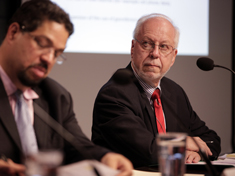-
Not Just Climate Change: Marcel Leroy on How Demography Contributes to Africa’s Scarcity Problems
June 6, 2014 By Donald Borenstein
The Sahel has endured multiple debilitating food crises over the last five years and climate change has often been fingered as the culprit. But it is important to equally consider the amplifying effects of demographic trends on resource scarcity, says the University of Peace’s Marcel Leroy in this week’s podcast.
The Sahel has endured multiple debilitating food crises over the last five years and climate change has often been fingered as the culprit. But it is important to equally consider the amplifying effects of demographic trends on resource scarcity, says the University of Peace’s Marcel Leroy in this week’s podcast.
Leroy, with 20 years of field work in the Horn of Africa and experience in academia and the diplomatic service – including as the European Union’s special representative to Sudan from 2005 to 2008 – says too often “we base assumptions on how to adapt to climate change on what we observe about climate change, or what we think we observe, which isn’t always that well founded.”
“Scarcity in these regions…results from the effects of climate change combined with the effects of population increase,” he says. Many of the Sahel countries, including Mali, Burkina Faso, Niger, Nigeria, and Chad, have very high total fertility rates – the number children per woman – guaranteeing rapid population growth for some time into the future (especially if more isn’t done to meet unmet need for contraception). “Even if the climate wasn’t changing, but the population was rising at three percent a year as it was in these countries, per capita availability of these resources is going to decline.”
Africa, as a continent, is not drying out as drastically as it might seem, he says:
The greening of the Sahel, which is visible from satellite images, is the result of increases in precipitation from 1990 onwards. This doesn’t mean that the Sahel has become more hospitable in terms of sustaining life or animals, because since there had been overgrazing, there was very little seed reserve in the ground, and a lot of the greening turns out to be invasive species, which are not suitable as farming crops. Nevertheless, the amount of rainfall has not uniformly declined.
Instead resource scarcity is being propelled by other factors. “Some of the areas that have had decreases in precipitation are areas that have had the highest population increase,” he says. Ethiopia is projected to more than double in population over the next 20 to 30 years, perhaps reaching as high as 200 million people by 2050.
“Very often when you talk of problems that are induced by climate change, even by articles done by scholars who do or should know better, there is no attempt to disaggregate the effect of climate change and population increase,” Leroy says.
“My advice to students and colleagues in both of my professions has always been, ‘don’t believe anything if you can avoid it.’ In other words: be critical; don’t take things at face value.”
Marcel Leroy Spoke at the Wilson Center on May 14. Download his slides to follow along.
Friday podcasts are also available for download on iTunes.
 A Publication of the Stimson Center.
A Publication of the Stimson Center.







